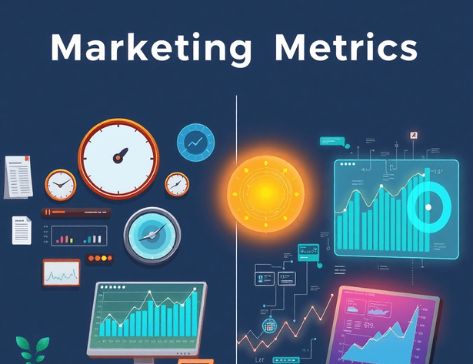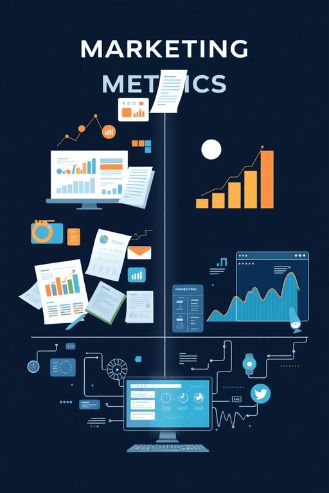
Marketing Metrics Evolution: From Traditional to Digital Analytics
The marketing metrics evolution has fundamentally transformed how businesses measure success, moving from simple sales figures to sophisticated, multi-dimensional analytics that provide unprecedented insights into customer behavior and campaign performance. This transformation represents one of the most significant shifts in business intelligence over the past several decades.
Understanding this evolution is crucial for modern marketers who need to navigate an increasingly complex landscape of data points, attribution models, and performance indicators. The journey from traditional marketing measurement to today’s advanced analytics mastery reveals fascinating insights about how technology has revolutionized business decision-making processes.

The Traditional Marketing Metrics Era
In the pre-digital age, marketing metrics were relatively straightforward but limited in scope. Businesses primarily relied on basic measurements such as total sales revenue, market share, and brand awareness surveys. These traditional metrics, while foundational, provided only a surface-level view of marketing effectiveness.
The primary traditional marketing metrics included:
- Sales Revenue: The most fundamental metric measuring total income generated
- Market Share: Percentage of total market captured by the business
- Brand Awareness: Measured through surveys and focus groups
- Reach and Frequency: How many people saw advertisements and how often
- Cost Per Thousand (CPM): Cost to reach 1,000 potential customers
These metrics served their purpose but lacked the granularity and real-time insights that modern businesses require. The measurement process was often delayed, expensive, and provided limited actionable intelligence for optimization.
The Digital Revolution and Metric Transformation
The advent of digital marketing fundamentally changed the metrics landscape. Suddenly, marketers could track user interactions in real-time, measure engagement at granular levels, and attribute conversions to specific touchpoints along the customer journey.
This digital transformation introduced revolutionary concepts such as:
- Click-Through Rates (CTR): Measuring engagement with digital advertisements
- Conversion Rates: Tracking the percentage of visitors who complete desired actions
- Customer Acquisition Cost (CAC): Calculating the total cost to acquire each new customer
- Lifetime Value (LTV): Predicting total revenue from customer relationships
- Return on Ad Spend (ROAS): Measuring revenue generated per dollar spent on advertising
Pro Tip: The key to successful metric evolution lies in balancing traditional brand metrics with digital performance indicators to create a comprehensive measurement framework.
Advanced Analytics and Predictive Modeling
Modern marketing metrics have evolved beyond simple tracking to incorporate sophisticated analytical techniques. Predictive analytics now enables marketers to forecast future performance, identify trends before they fully emerge, and optimize campaigns proactively rather than reactively.
Contemporary advanced metrics include:
- Attribution Modeling: Understanding the contribution of each touchpoint in the customer journey
- Cohort Analysis: Tracking groups of customers over time to understand behavior patterns
- Sentiment Analysis: Measuring brand perception through social media and review monitoring
- Engagement Quality Scores: Evaluating the depth and meaningfulness of customer interactions
- Predictive Customer Lifetime Value: Using machine learning to forecast long-term customer worth
Multi-Channel Attribution and Cross-Platform Measurement
One of the most significant challenges in modern marketing metrics is accurately attributing conversions across multiple channels and devices. Today’s customers interact with brands through numerous touchpoints before making purchasing decisions, creating complex attribution puzzles that require sophisticated solutions.
Effective multi-channel measurement strategies involve:
- First-Touch Attribution: Crediting the initial interaction that introduced the customer
- Last-Touch Attribution: Assigning conversion credit to the final touchpoint
- Linear Attribution: Distributing credit equally across all touchpoints
- Time-Decay Attribution: Giving more credit to recent interactions
- Data-Driven Attribution: Using machine learning to determine optimal credit distribution
Real-Time Analytics and Agile Marketing
The evolution toward real-time metrics has enabled agile marketing approaches that allow for immediate optimization and rapid response to market changes. This shift from periodic reporting to continuous monitoring has revolutionized how marketing teams operate and make decisions.
Real-time marketing metrics provide several advantages:
- Immediate identification of underperforming campaigns
- Rapid optimization opportunities
- Enhanced budget allocation efficiency
- Improved customer experience through timely adjustments
- Competitive advantage through faster market response
Privacy-First Metrics and Cookieless Future
Recent privacy regulations and the impending cookieless future have forced another evolution in marketing metrics. Marketers must now develop measurement strategies that respect user privacy while maintaining analytical effectiveness.
Privacy-compliant measurement approaches include:
- First-Party Data Collection: Building direct relationships with customers
- Contextual Targeting: Using content context rather than personal data
- Aggregated Analytics: Analyzing trends without individual identification
- Consent-Based Tracking: Implementing transparent opt-in mechanisms
- Server-Side Tracking: Reducing reliance on browser-based cookies
Implementing Modern Marketing Metrics: Step-by-Step Guide
Successfully implementing evolved marketing metrics requires a systematic approach. Follow these essential steps to modernize your measurement framework:
Step 1: Audit Current Metrics
Begin by evaluating existing measurement practices. Identify gaps between current capabilities and business objectives. Document all data sources, tracking methods, and reporting processes.
Step 2: Define Key Performance Indicators (KPIs)
Establish clear, measurable objectives aligned with business goals. Prioritize metrics that directly impact revenue and customer satisfaction. Ensure KPIs are specific, measurable, achievable, relevant, and time-bound.
Step 3: Implement Tracking Infrastructure
Deploy necessary tracking tools and technologies. This may include analytics platforms, customer relationship management systems, and marketing automation tools. Ensure proper data integration across all platforms.
Step 4: Establish Reporting Frameworks
Create standardized reporting templates and dashboards. Implement automated reporting where possible to ensure consistency and timeliness. Design reports for different stakeholder needs and technical expertise levels.
Step 5: Train Team Members
Provide comprehensive training on new metrics and tools. Ensure team members understand how to interpret data and make data-driven decisions. Establish ongoing education programs to keep pace with evolving technologies.
Future Trends in Marketing Metrics Evolution
The marketing metrics landscape continues evolving rapidly. Emerging trends include artificial intelligence-powered analytics, voice search optimization metrics, augmented reality engagement tracking, and blockchain-based attribution verification.
Marketers should prepare for:
- Increased automation in data collection and analysis
- More sophisticated predictive modeling capabilities
- Enhanced cross-device tracking solutions
- Improved integration between online and offline metrics
- Greater emphasis on customer experience metrics
Conclusion
The marketing metrics evolution represents a fundamental shift from intuition-based decision making to data-driven strategy development. Modern marketers who embrace this evolution and implement comprehensive measurement frameworks will gain significant competitive advantages in understanding customer behavior, optimizing campaign performance, and driving business growth.
Success in today’s marketing environment requires continuous adaptation to new measurement technologies and methodologies. By leveraging advanced analytics, respecting privacy requirements, and maintaining focus on meaningful business outcomes, organizations can harness the full power of evolved marketing metrics. The future belongs to those who can effectively measure, analyze, and act upon the wealth of data available in our increasingly connected world. Consider exploring native advertising platforms to enhance your measurement capabilities and stay ahead of the competition.


